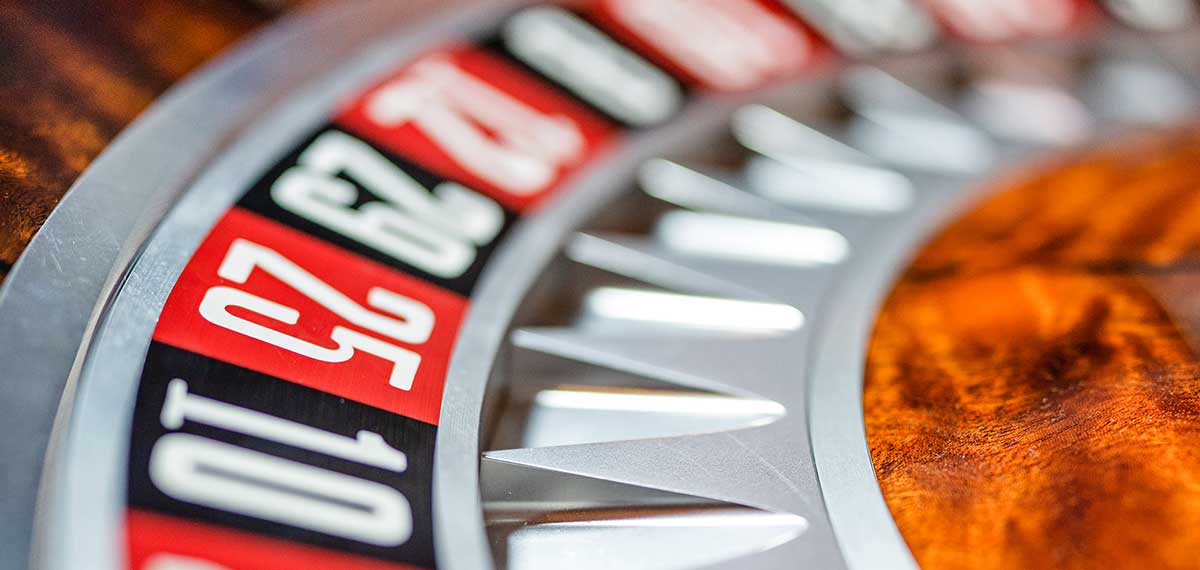
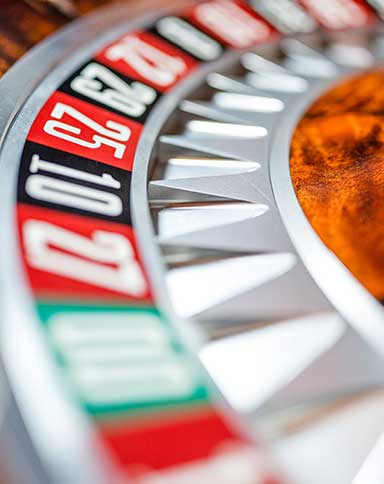
Table Games
Come join our tables at a variety of casinos throughout the country!
With every flip of the card and roll of the dice, Boyd is the place to enjoy the best in exciting table games casino action! Whether you're looking for a classic game like blackjack, craps, roulette, or one of your favorite new games, you can be sure that Boyd has a table waiting for you.
Table Games in Las Vegas
Try your hand at the hottest live table games in Nevada!
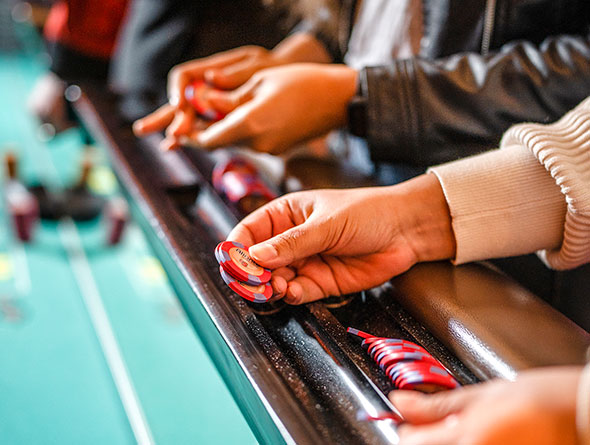
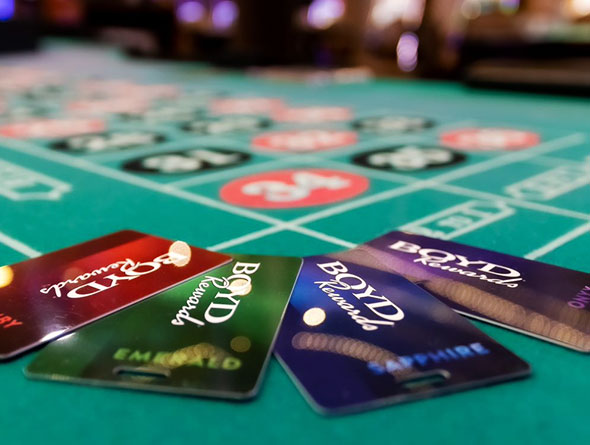
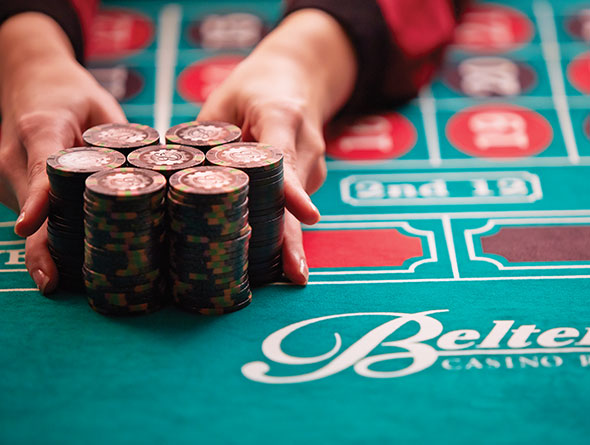
Table Games in the Midwest and Northeast
Heart-pounding tables action in Illinois, Indiana, Iowa, Kansas, Missouri, Ohio, and Pennsylvania!
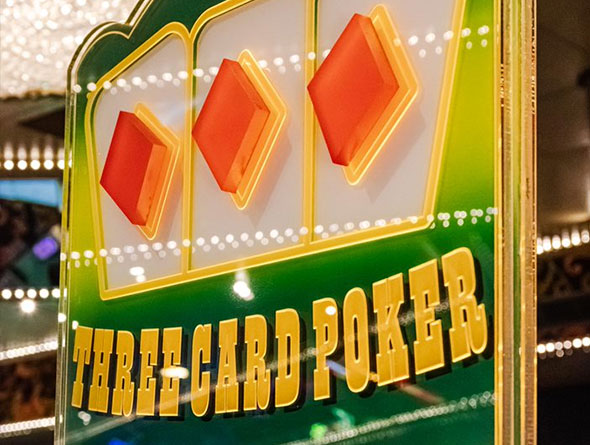
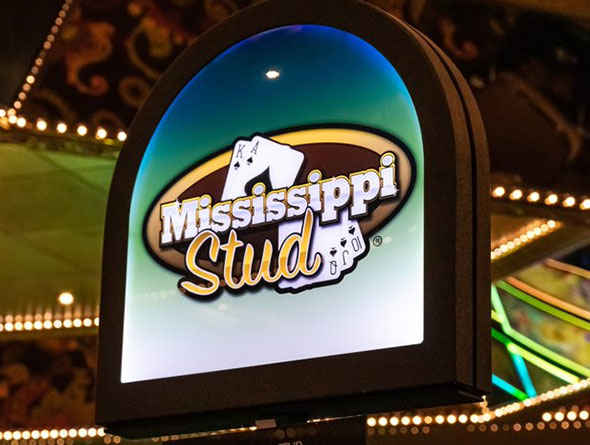
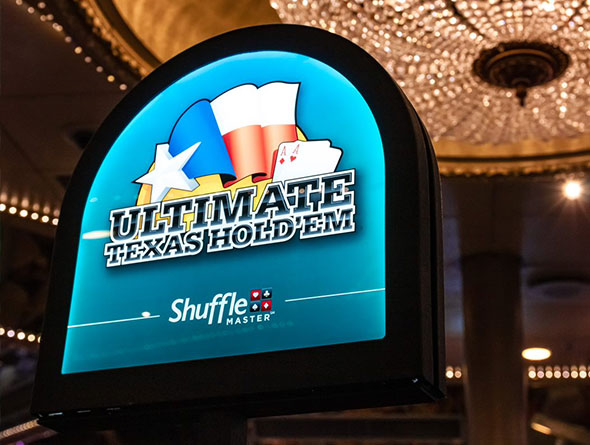
Table Games in the South
Exciting varieties of table games await in Mississippi and Louisiana!
Table Game Basics
Blackjack
Perhaps the most popular casino table game is Blackjack.
The object is to draw cards closer in value to 21 than the dealer’s cards without exceeding 21. To play, you place a bet on the table in the betting circle in front of you. The dealer shall deal you two cards face-up and two cards to the dealer; one face-up and one face-down. The second card is the “hole card.” The dealer then proceeds left to right around the table, announcing card point totals. Any card from 2 to 10 counts at face value; Jacks, Queens and Kings are counted as 10; and the Ace is counted as 11 unless that would produce a point total in excess of 21, in which case it is then counted as 1. Players are responsible for correctly computing their card point totals.
The object is to draw cards closer in value to 21 than the dealer’s cards without exceeding 21. To play, you place a bet on the table in the betting circle in front of you. The dealer shall deal you two cards face-up and two cards to the dealer; one face-up and one face-down. The second card is the “hole card.” The dealer then proceeds left to right around the table, announcing card point totals. Any card from 2 to 10 counts at face value; Jacks, Queens and Kings are counted as 10; and the Ace is counted as 11 unless that would produce a point total in excess of 21, in which case it is then counted as 1. Players are responsible for correctly computing their card point totals.
Craps
Craps is played by placing various bets on a Craps table and throwing two dice to the opposite end of the table. Each roll is independent and the game moves at a brisk pace.
Roulette
Roulette is an exciting game of chance.
A Double Zero Roulette wheel has thirty-six (36) numbers from 1 to 36, 0 and 00. The numbers are alternately colored red and black with 0 and 00 colored green. The Roulette layout is numbered and colored the same as the Roulette wheel. A Double Zero Roulette wheel has 38 equally-spaced compartments on the wheel. Players may place bets with colored Roulette chips on any number or combination of numbers on the Roulette table. Chips are sold as a single color to a player to differentiate between multiple players. The color chip values are determined by the amount the player pays for the original stack of 20.
The Roulette wheel is spun in one direction while the dealer spins the Roulette ball in the opposite direction. Players may place bets on any number, combination of numbers or section of numbers, red or black colors, odd or even numbers or 0 and/or 00. The dealer signals the end of betting by saying, “No more bets.” Please remember, where players place their chips on the Roulette table determines their bet and the player is responsible for the chips’ correct placement. After the ball falls onto a number on the Roulette wheel, the dealer calls out the winning number and places the marker “Dolly” on it. All losing bets are collected and winning bets are paid.
A Double Zero Roulette wheel has thirty-six (36) numbers from 1 to 36, 0 and 00. The numbers are alternately colored red and black with 0 and 00 colored green. The Roulette layout is numbered and colored the same as the Roulette wheel. A Double Zero Roulette wheel has 38 equally-spaced compartments on the wheel. Players may place bets with colored Roulette chips on any number or combination of numbers on the Roulette table. Chips are sold as a single color to a player to differentiate between multiple players. The color chip values are determined by the amount the player pays for the original stack of 20.
The Roulette wheel is spun in one direction while the dealer spins the Roulette ball in the opposite direction. Players may place bets on any number, combination of numbers or section of numbers, red or black colors, odd or even numbers or 0 and/or 00. The dealer signals the end of betting by saying, “No more bets.” Please remember, where players place their chips on the Roulette table determines their bet and the player is responsible for the chips’ correct placement. After the ball falls onto a number on the Roulette wheel, the dealer calls out the winning number and places the marker “Dolly” on it. All losing bets are collected and winning bets are paid.
Baccarat
Baccarat is a game dating back to ancient times.
It is played with 8 decks of cards and the object is to get a point count closest to 9. Picture cards, 10s and any combination of cards totaling 10 have no value. All other cards are counted at face value. An Ace is valued at 1. The “modern” innovations of Mini Baccarat have recently been developed and are played basically the same as regular Baccarat, however, the table sizes vary. Midi Baccarat is another exciting version of Baccarat. It is the only version where players can handle the cards that are dealt to them. Two cards are dealt to the player’s hand and two are dealt to the banker’s hand.
The dealer will call out the point totals of each hand. If the point value of the first two (2) cards drawn for either hand is an 8 or 9, it is called a “natural” and no additional cards will be drawn.
It is played with 8 decks of cards and the object is to get a point count closest to 9. Picture cards, 10s and any combination of cards totaling 10 have no value. All other cards are counted at face value. An Ace is valued at 1. The “modern” innovations of Mini Baccarat have recently been developed and are played basically the same as regular Baccarat, however, the table sizes vary. Midi Baccarat is another exciting version of Baccarat. It is the only version where players can handle the cards that are dealt to them. Two cards are dealt to the player’s hand and two are dealt to the banker’s hand.
The dealer will call out the point totals of each hand. If the point value of the first two (2) cards drawn for either hand is an 8 or 9, it is called a “natural” and no additional cards will be drawn.
Mini Baccarat
A guest has the choice of three bets on any Mini Baccarat game; the banker, the player and the tie. Guests choose sides and place their bets. When all are placed, the dealer will announce, “No more bets”, and then deal the cards. Whichever side has a point total closer to 9 wins. If both the player’s and the banker’s hand have the same total, it is declared a tie. Winning player and/or banker bets are paid 1 to 1 and ties are paid 8 to 1. A winning banker’s hand is charged a 5% commission. The commission will be collected by the dealer at the time the winning hand is paid.
Unless the banker’s hand is a “natural” (8 or 9), the player’s hand shall draw a third card if the point count of the player’s hand is 5 or less and will not draw a card if the point count is 6 or more.
When wagering only the Tie, the wager must meet the table minimum.
Unless the banker’s hand is a “natural” (8 or 9), the player’s hand shall draw a third card if the point count of the player’s hand is 5 or less and will not draw a card if the point count is 6 or more.
When wagering only the Tie, the wager must meet the table minimum.
Pai Gow
Pai Gow is an ancient Chinese game which is played with a set of 32 dominoes or “tiles.” Each tile has a numeric value and a symbol ranking. The 32 dominoes used in Pai Gow are shuffled by the dealer. The dominoes are placed in eight stacks of four. The players place their wagers and the dealer announces, “No more bets.” The banker then shakes the Pai Gow Shaker containing three dice, three times. The sum of these dice determines which player will receive the first stack of dominoes. The banker is always counted as seat number 1, 9 or 17 and the count proceeds counterclockwise beginning with the banker. The dealer and each seated player are dealt one stack each and arrange their dominoes into two hands of two tiles each (a high hand and a low hand) and then sets both hands face down on the layout behind their bet. The object of the game is to have players set their hands so they have both combinations higher than the hands of their opponent.
Once players have set their hand and they place their dominoes face down on the table, players are not allowed to touch the dominoes again. Players must keep the four tiles in full view of the dealer at all times. Players are responsible for setting their own tiles and no other player may touch the tiles. A player may ask for assistance from the dealer in setting their hand according to the House Ways. The dealer is the only other person allowed to touch a player’s tiles. The dealer will always set their hand using a set of rules known as “House Ways.” When a player and the banker have two dominoes totaling the same number, the combinations with the higher “single ranking” domino is the winner. When the two tiles that form the highest ranking hand “The Supreme Pair” (Gee Joon) are used separately, the numeric value is interchangeable. The 3 can be counted as a 6 and the 6 can be counted as a 3. When two hands have the same numeric value and identical high tiles, it is called a “Copy Hand.” All Copy Hands are won by the bank.
Once players have set their hand and they place their dominoes face down on the table, players are not allowed to touch the dominoes again. Players must keep the four tiles in full view of the dealer at all times. Players are responsible for setting their own tiles and no other player may touch the tiles. A player may ask for assistance from the dealer in setting their hand according to the House Ways. The dealer is the only other person allowed to touch a player’s tiles. The dealer will always set their hand using a set of rules known as “House Ways.” When a player and the banker have two dominoes totaling the same number, the combinations with the higher “single ranking” domino is the winner. When the two tiles that form the highest ranking hand “The Supreme Pair” (Gee Joon) are used separately, the numeric value is interchangeable. The 3 can be counted as a 6 and the 6 can be counted as a 3. When two hands have the same numeric value and identical high tiles, it is called a “Copy Hand.” All Copy Hands are won by the bank.
Pai Gow Poker
Pai Gow Poker is a seven-card poker game, which has a five-card hand and a two-card hand.
A Joker is utilized in this game and is Wild, meaning it can either complete a straight or above, or may act as an Ace. Each player will receive seven cards and from them will set a five-card hand and a two-card hand according to poker rankings. The five-card hand must be equal to or higher than the two-card hand. Each player will make a Pai Gow Poker wager before the cards are dealt. Once all bets are made, the dealer will deliver seven cards to each spot of the game, including unplayed spots. Wagers must be made in increments of $5.
A Joker is utilized in this game and is Wild, meaning it can either complete a straight or above, or may act as an Ace. Each player will receive seven cards and from them will set a five-card hand and a two-card hand according to poker rankings. The five-card hand must be equal to or higher than the two-card hand. Each player will make a Pai Gow Poker wager before the cards are dealt. Once all bets are made, the dealer will deliver seven cards to each spot of the game, including unplayed spots. Wagers must be made in increments of $5.
Spanish 21
The game is played with a Spanish Deck of 48 cards; 2-9, J, Q, K, A; no number 10 cards. All cards count as their face value with the exception of Kings, Queens and Jacks, which count as 10. Aces count as either 1 or 11. Spanish 21 is played like Blackjack with the following exceptions: Player’s Blackjack, Player’s Total of 21, Insurance, Splitting Pairs, Re-Splitting Pairs, Double Down, Double Down Rescue, Surrender, Match the Dealer, and Match the Dealer Payoff.
Ultimate Texas Hold'em
Ultimate Texas Hold’em is similar to traditional poker except it features headto-head play against the dealer (players do not compete against each other) and an optional bonus wager that pays odds if the player’s five-Card hand is three-of-a-kind (Trips) or better. The Ante and Blind wagers are made against the dealer, but the Trips wager is against a posted pay table and not the dealer hand.
The object of the game is to beat the dealer by making the best five-card poker hand by a player using any combination of their two cards and the five community cards in the center of the layout. Before any cards are dealt, players make equal wagers in the Ante and Blind circle. The player can make the optional wager in the Trips area of the layout. Two cards are dealt to each player and the dealer. After this, players can either check (do nothing) or bet three to four times the Ante in the Play circle. The dealer then reveals the Three-Card Flop. If players have not already made a play wager, they can check or bet two times the Ante in the Play circle. The dealer then reveals the Turn and the River. Any player that has not made a Play wager yet must either make a Play wager equal to the Ante or Fold and lose the Ante and Blind wagers.
The object of the game is to beat the dealer by making the best five-card poker hand by a player using any combination of their two cards and the five community cards in the center of the layout. Before any cards are dealt, players make equal wagers in the Ante and Blind circle. The player can make the optional wager in the Trips area of the layout. Two cards are dealt to each player and the dealer. After this, players can either check (do nothing) or bet three to four times the Ante in the Play circle. The dealer then reveals the Three-Card Flop. If players have not already made a play wager, they can check or bet two times the Ante in the Play circle. The dealer then reveals the Turn and the River. Any player that has not made a Play wager yet must either make a Play wager equal to the Ante or Fold and lose the Ante and Blind wagers.
3-Card Poker - Progressive
Three-Card Poker is an exciting variation of stud poker in which players are challenged to make the best poker hand while playing with only three cards.
Players may bet against the dealer or bet on the value of their own three-card hand or both. An “Ante Bonus” shall be paid if a player is dealt one of the three highest ranking hands in the game. The Ante Bonus is paid regardless of the dealer’s hand.
Ante Bonus:
Straight: 1 to 1
3 of a Kind: 4 to 1
Straight Flush: 5 to 1
Players may bet against the dealer or bet on the value of their own three-card hand or both. An “Ante Bonus” shall be paid if a player is dealt one of the three highest ranking hands in the game. The Ante Bonus is paid regardless of the dealer’s hand.
Ante Bonus:
Straight: 1 to 1
3 of a Kind: 4 to 1
Straight Flush: 5 to 1
 Log In
Log In
